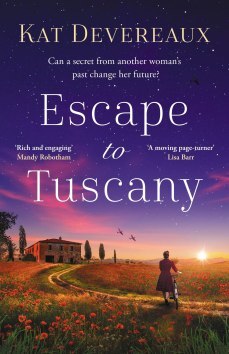Staffetta Partigiana – A Different Kind of Hero(ine)
I wasn’t familiar with the World War II Italian Resistance movement until I came across author Kat Devereaux and her debut novel Escape to Tuscany. Her fictional heroine is a brave young woman who is part of this movement. Kat kindly agreed to share some of her research and knowledge with us (plus her top writing tip!). Over to Kat:
When you think about the partisans who fought to liberate Italy during the German occupation, you might imagine Peppone. A communist hardliner with a red kerchief, a Stalin moustache and a fiery temper, Peppone (“Big Joe”) is the sympathetic antagonist of Giovanni Guareschi’s Don Camillo stories. He was played by Brian Blessed in the UK television adaptation, which tells you everything.
As with any caricature, there’s an element of truth to Peppone. Aligned with the Italian Communist Party, the Garibaldi Brigades were the heavy hitters of the resistance movement: organised, disciplined, and ferocious in battle. It’s not surprising that the image of the red-kerchiefed, gun-toting partisan is so iconic.
But there are many ways to resist. In my debut novel Escape to Tuscany, I chose to showcase another indispensable figure: the staffetta partigiana.
A different kind of hero(ine)
The resistance movements that sprang up after the German occupation of September 1943 had to work in extremely dangerous conditions. In the first months, partisan groups set up camp in the mountains, where local knowledge and harsh conditions worked to their advantage. As the war progressed and support for the partisans grew, the fight spread to the towns. And as Italy was liberated, city by city, partisan brigades played a leading role.
None of this could have been achieved without the staffette: the couriers who transported information, messages, supplies and armaments from place to place. Couriers needed to be inconspicuous and able to move easily even in crowded urban settings. They had to be able to pass through German checkpoints and elude the attention of sadistic Italian Fascist vigilante groups, such as the Black Brigades, who hunted partisans and their supporters. And they needed something to hold their cargo, something that wouldn’t stand out: a shopping bag, a school satchel, a bicycle basket.
So it’s no surprise that couriers were most often young women or teenage girls. My historical narrator Stella may be fictional, but she fits the profile of a courier perfectly. Just fourteen years old, she moves between her hometown of Romituzzo and the neighbouring towns of Castelmedici and San Damiano by train or bicycle, carrying intelligence, notes and even weapons. She has to fear violence from Germans and Fascists alike—sometimes she has to witness it. Stella operates in the shadows, unseen and undersung. But the stories she has to tell speak of tremendous courage.
Many women, many voices
I had a wealth of inspiration when writing Stella’s story. Thankfully for posterity, some of the women who worked as couriers during the occupation have left their testimonies behind. While most of these are in Italian, there are some English resources available. A wonderful place to start is the documentary Bandite, made in 2009 and available for free. You can find a subtitled version here https://youtu.be/iwJlwdBGBQ4.
For years after the Liberation, women partisans were denied the recognition they deserved. This has changed in the last decades, and now the staffetta on her bicycle is a symbol of antifascist resistance. That’s entirely as it should be.
My top writing tip
When researching a historical novel, it’s easy to get caught up in research and end up down a rabbithole. If you come across a book, video or other resource that’s absolutely fascinating but not relevant to what you’re writing at this precise moment, don’t get sidetracked. But don’t dismiss it, either: keep a note of it and store it somewhere easy to find. You never know what stories it might spark in the future.
Thank you, Kat!
Escape to Tuscany will be published on July 6th 2023 and is available to pre-order now. It is described as “A gripping and moving debut novel about two women, decades apart, whose fates converge in Florence, Italy. Perfect for fans of Patricia Wilson, Carol Kirkwood and Lucinda Riley.” Regular readers of this blog will know that I am a great fan of Lucinda Riley’s Seven Sisters series – so Escape to Tuscany sounds right up my street!
About the book:
Romituzzo, 1944
Just fourteen, Stella Infuriati is the youngest member of her town’s resistance network – a secret she keeps even from her parents. She works alongside her brother Achille to relay messages, supplies, and weapons to partisan groups in the Tuscan hills. Fuelled by courage and a fierce sense of purpose, Stella braves incredible danger and survives … but when peace comes in 1945, she vanishes.
Florence, 2019
Writer Tori MacNair arrives in Florence. Fleeing an emotionally abusive marriage, she’s come to build a new life in the city her grandmother taught her to love. As she digs into her family history, Tori uncovers decades-old secrets: the story of a brave young woman who risked everything to save her world.

Rosa – Kat’s Writing Assistant
About Kat:
Born near Edinburgh, Kat Devereaux lived all over the globe before finally settling in Italy in 2019.
As a writer, Kat loves big, controversial personalities, spectacular settings and high-stakes conflict. The rest of the time, she likes being very quiet in libraries. In her everyday life, she is a freelance writer and translator with a special focus on Italian literature, history and religion.



